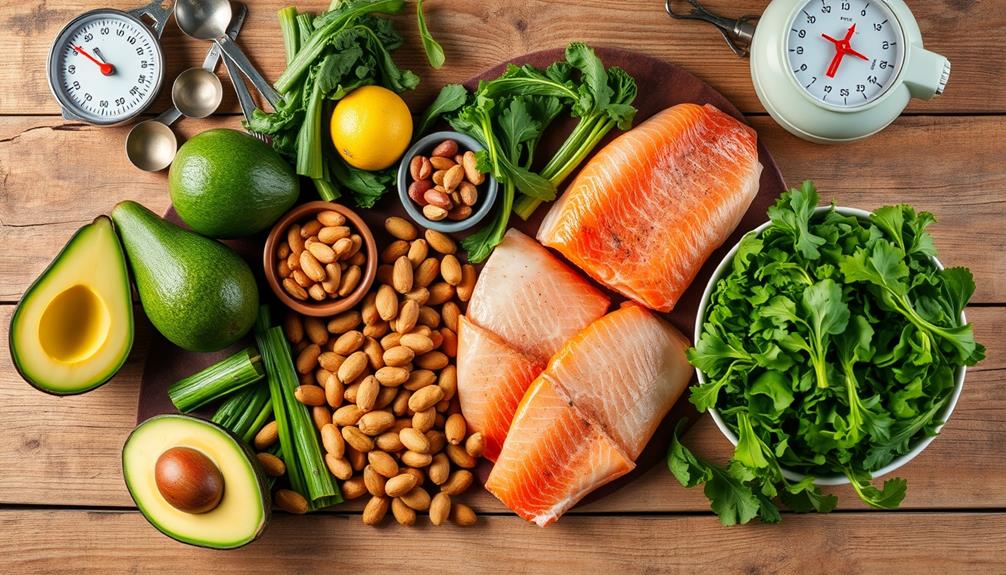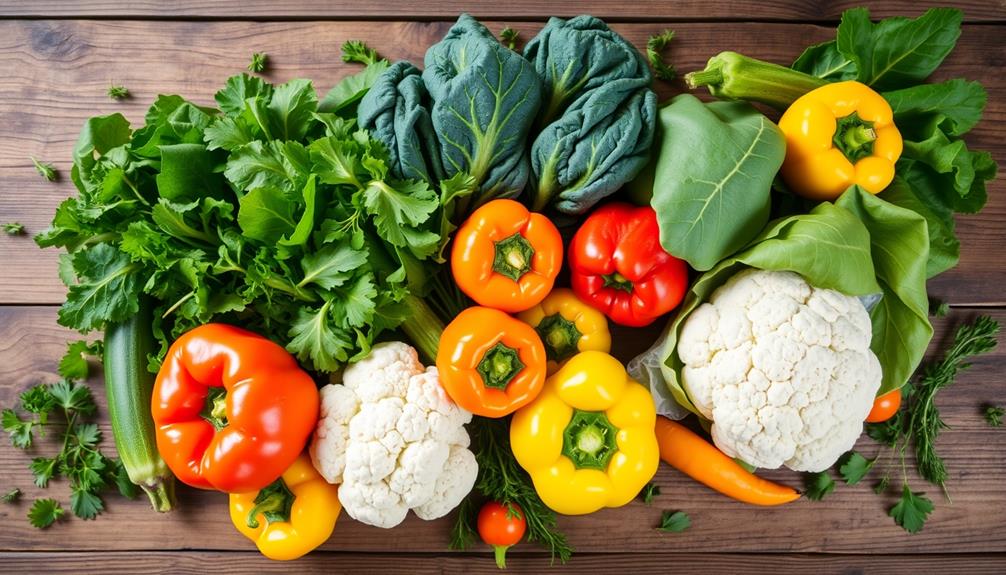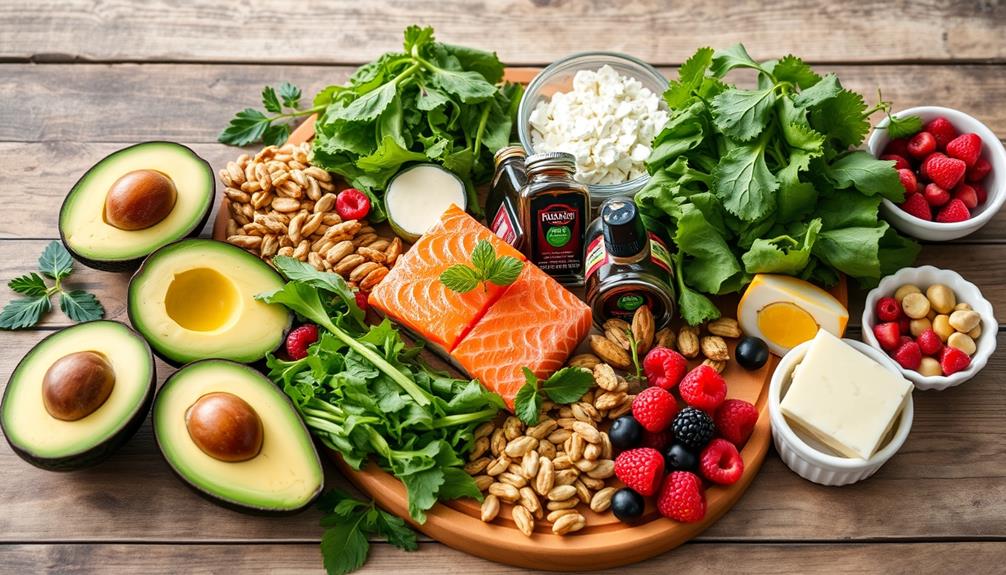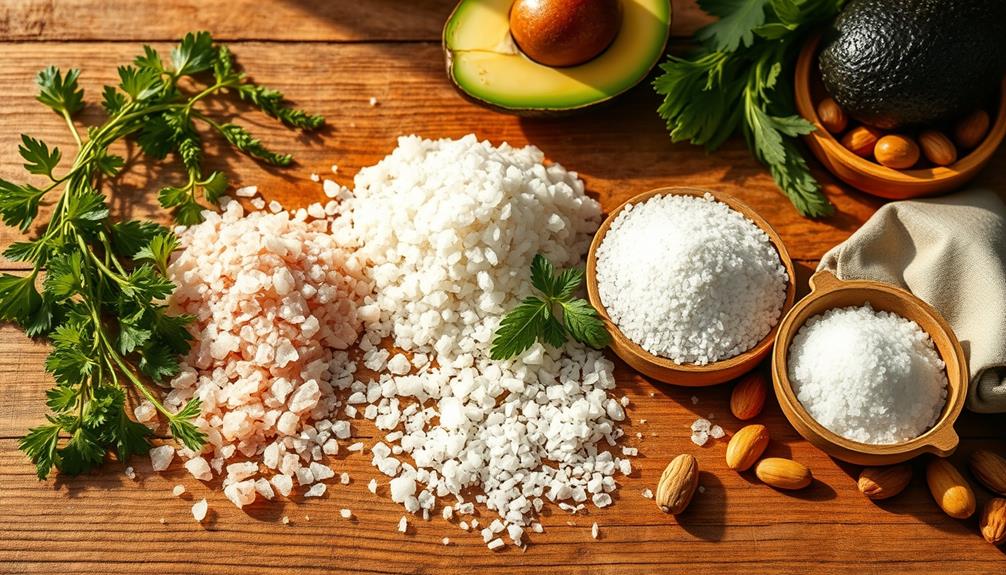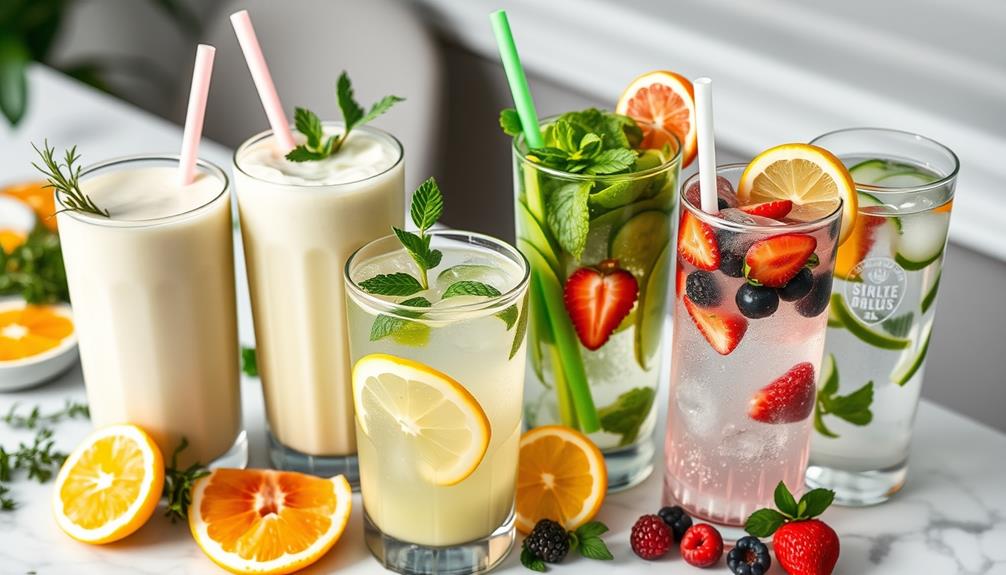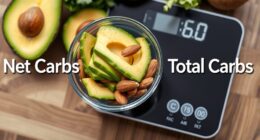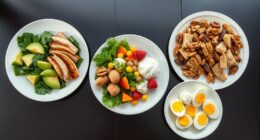You'll find that the ketogenic diet, a low-carb, high-fat eating plan, can be a great tool for weight loss and health improvement. By shifting your body's energy source, you'll enjoy potential benefits like reduced hunger, improved insulin sensitivity, and even cognitive support. There are different types of keto diets tailored to fit your lifestyle, from Standard to Targeted. You'll also want to know what foods to include, like fatty meats and low-carb veggies, while avoiding sugars and grains. Stick with it, and you might just discover the lasting advantages of going keto. There's plenty more to explore!
Key Takeaways
- The ketogenic diet emphasizes high-fat, low-carb intake to shift the body's energy source from glucose to ketones, promoting fat metabolism.
- Common types of ketogenic diets include Standard, High Protein, Targeted, and Cyclical, catering to different lifestyle and fitness goals.
- Potential health benefits include improved insulin sensitivity, weight loss, and reduced seizure frequency in epilepsy patients.
- Common side effects, known as "keto flu," may include fatigue, headaches, and digestive issues during the initial transition phase.
- Long-term risks include increased LDL cholesterol, nutrient deficiencies, and gastrointestinal issues, necessitating medical supervision for safe adherence.
Overview of the Keto Diet
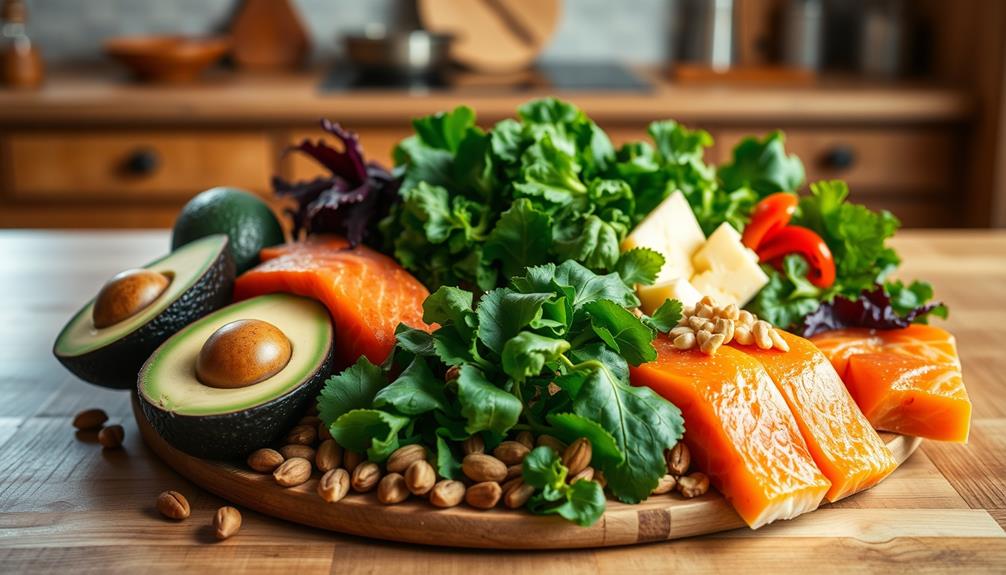
The ketogenic diet, often referred to simply as keto, is a low-carb, high-fat eating plan that shifts your body's energy source from glucose to ketones. Originating in the 1920s as a treatment for epilepsy, the ketogenic diet focuses on a high-fat, low-carbohydrate, and moderate protein intake to induce ketosis, a metabolic state that enhances energy production from fat.
Additionally, this diet may have implications for overall health, similar to how daily consumption of cranberry juice can provide antioxidants and support kidney health. A typical macronutrient breakdown for the keto diet consists of approximately 75% fats, 20% protein, and only 5% carbohydrates, with daily carb limits usually below 20-50 grams.
Common foods allowed on this diet include meat, fatty fish, eggs, dairy, low-carb vegetables, nuts, and seeds, while sugary foods, grains, most fruits, and root vegetables are restricted.
The primary goal is to promote fat metabolism and shift your body's fuel source away from glucose, which can lead to effective weight loss. However, keep in mind that while the keto diet can help you shed pounds, it may limit food variety and contradict general dietary guidelines regarding saturated fat and fiber intake.
Types of Ketogenic Diets
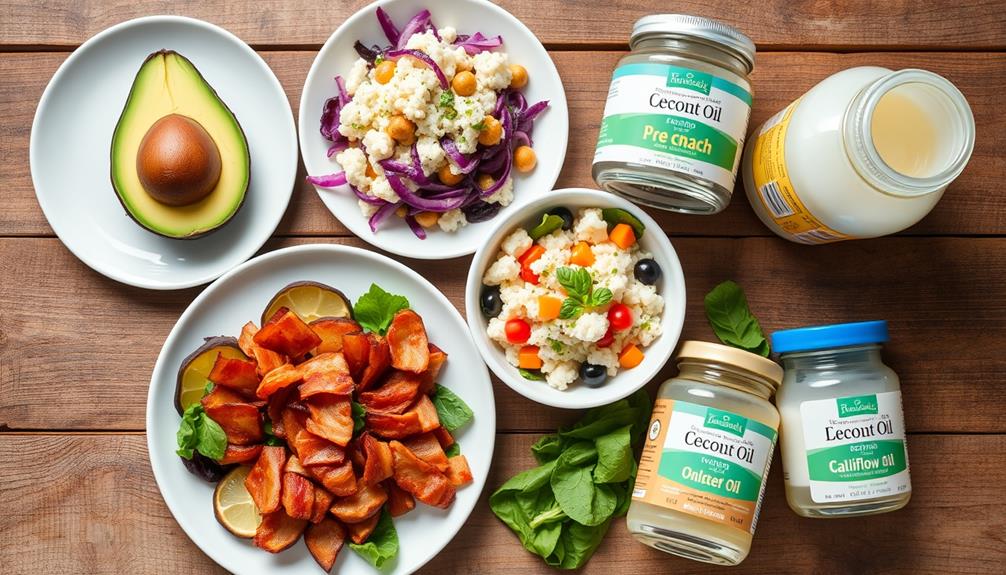
Different types of ketogenic diets cater to various lifestyles and fitness goals, each with unique macronutrient ratios.
The Standard Ketogenic Diet (SKD) is the most common form, comprising about 70% fats, 20% protein, and 10% carbohydrates. This approach aims to induce ketosis for effective fat burning.
If you prefer a higher protein intake, the High Protein Ketogenic Diet might suit you better, typically consisting of 60% fats, 35% protein, and just 5% carbs. It's important to select the right diet that aligns with your health goals and preferences, much like choosing effective cold medications for symptom relief.
For those who engage in high-intensity exercise, the Targeted Ketogenic Diet allows for extra carbohydrate intake around workouts, helping maintain energy levels while still promoting fat burning.
Alternatively, the Cyclical Ketogenic Diet offers a different strategy—five days of a low carb diet followed by two days of higher carb consumption to replenish glycogen stores.
Each of these types of ketogenic diets can help you achieve ketosis, but the right choice depends on your individual lifestyle and fitness goals.
Health Benefits and Risks
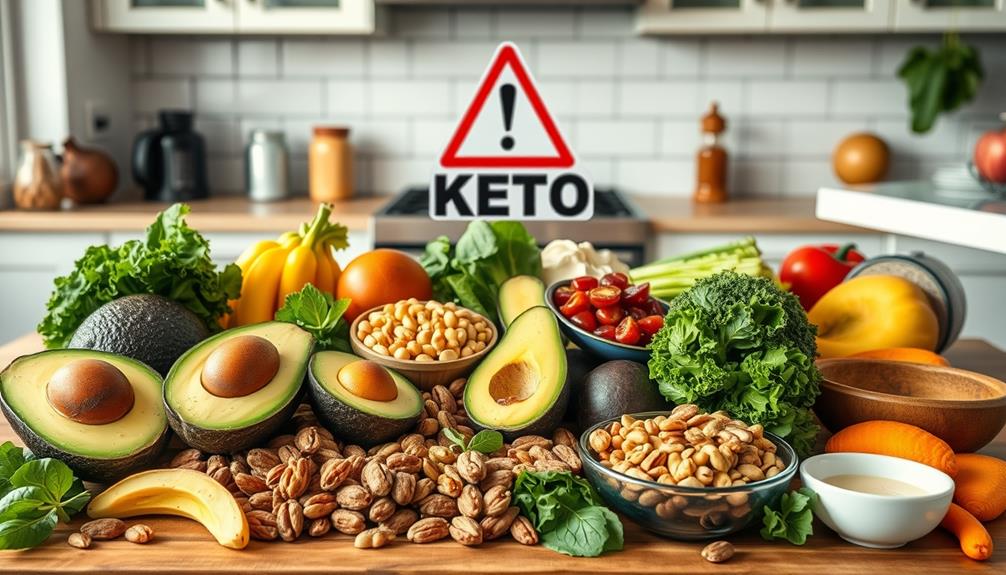
When you consider the ketogenic diet, you might be intrigued by its potential health benefits, like weight loss and improved blood sugar control.
Incorporating regular physical activity and following a balanced diet rich in whole foods can further enhance these benefits, making it essential to optimize health with a keto diet.
However, it's also important to be aware of common side effects, such as fatigue and headaches, that can occur as your body adjusts.
Long-term risks, including nutrient deficiencies and increased cholesterol levels, should also be on your radar as you evaluate this dietary approach.
Potential Health Benefits
Numerous studies highlight the potential health benefits of the ketogenic diet, particularly for specific medical conditions. For instance, this diet has shown significant promise in reducing seizure frequency in children with epilepsy, making it a valuable treatment option.
Additionally, the ketogenic diet may improve insulin sensitivity and lower insulin levels, which can be particularly beneficial for managing polycystic ovary syndrome (PCOS) and type 2 diabetes. Understanding the significance of budgeting for health expenses can help individuals effectively manage the costs associated with dietary changes.
Research suggests that the diet might even slow tumor growth in certain cancer types, thanks to reduced insulin levels and lower glucose availability. Moreover, you might experience improvements in cognitive function and symptoms if you're dealing with Alzheimer's disease or other neurodegenerative conditions, although more research is necessary to confirm these effects.
While the ketogenic diet can promote weight loss and enhance metabolic health, it's important to be aware of potential risks, such as nutrient deficiencies and elevated LDL cholesterol levels.
As a result, it's vital to pursue this diet under medical supervision to guarantee you're reaping the benefits while minimizing any adverse effects.
Common Side Effects
Shifting to a ketogenic diet can lead to a range of common side effects, often collectively termed "keto flu." You might experience symptoms like fatigue, headaches, irritability, and digestive issues, including constipation or diarrhea, particularly within the first week as your body adapts to burning fat for fuel.
Additionally, maintaining good oral health during this change is important, as some essential oils, such as clove oil, can help manage discomfort and promote overall wellness.
Here are three common side effects you may face:
- Fatigue and Headaches: You may feel unusually tired and suffer from headaches as your body shifts from carbs to fat.
- Digestive Issues: Constipation or diarrhea can occur as your gut adjusts to a new dietary regime.
- Keto Breath: An increase in acetone production can lead to changes in breath odor, known as "keto breath," which might stick around until you fully adapt.
While you might enjoy rapid weight loss at first, it's essential to be aware of potential nutrient deficiencies.
Always consult with a healthcare professional to make sure you manage these common side effects and understand the health benefits of the ketogenic diet.
Taking these precautions will help you change more smoothly while minimizing risks.
Long-Term Risks
Maintaining a ketogenic diet over the long term can pose various health risks that you should be aware of. One significant concern is the potential for increased LDL cholesterol levels, which may raise issues related to cardiovascular health.
Financial considerations for elderly care should also be factored in when evaluating lifestyle changes. Long-term adherence may also lead to nutrient deficiencies since the diet restricts many fruits, whole grains, and legumes that provide vital vitamins and minerals.
Additionally, the high protein intake associated with the keto diet could result in kidney overload, especially for individuals with pre-existing kidney conditions. Chronic low fiber consumption due to limited carbohydrate sources can lead to gastrointestinal issues, like constipation, which negatively impacts your digestive health.
Moreover, if you have existing liver conditions, the increased fat metabolism required while in a state of ketosis may exacerbate those issues.
Consequently, it's important to consult with healthcare professionals before committing to this diet long-term. They can help you monitor your health and suggest ways to mitigate these risks while still pursuing your dietary goals.
Being informed is significant for making the best decisions regarding your health on a ketogenic diet.
Foods to Include and Avoid
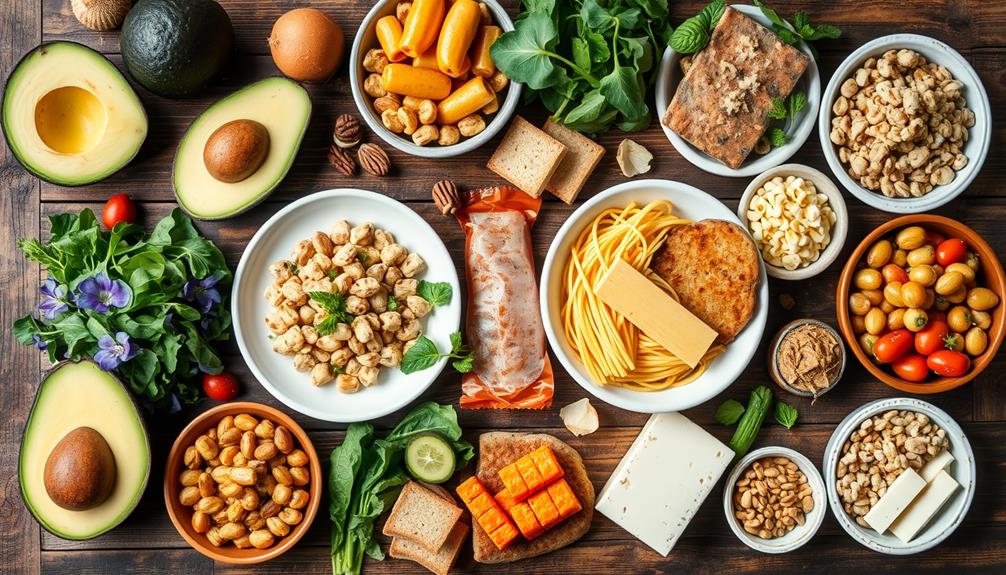
When following the keto diet, you'll want to focus on high-fat foods like fatty fish, meats, eggs, and low-carb vegetables to hit your macronutrient goals. In addition, incorporating healthy fats such as avocados, olive oil, and coconut oil into your meals can help you stay satiated and support your body’s nutritional needs. When planning your meals, it can be helpful to follow the keto nutritional pyramid secrets, which emphasize the importance of prioritizing fats, moderate protein intake, and minimal carbohydrates. By following these guidelines, you can ensure you are getting the right balance of nutrients to support your keto diet and achieve your health and weight loss goals. If you’re looking for tasty keto breakfast recipes, consider incorporating dishes like avocado and egg breakfast bowls, keto-friendly pancakes made with almond flour, or a breakfast skillet with bacon, eggs, and spinach. These recipes are not only delicious but also align with the high-fat and low-carb requirements of the keto diet, making them a great way to start your day on the right nutritional track. As you explore different recipes, be sure to include a variety of healthy fats and protein sources to keep your meals satisfying and in line with your keto goals.
It's important to be aware of potential health screenings such as mammography guidelines that could impact overall health considerations while on any diet.
At the same time, it's essential to steer clear of sugary foods, grains, and starchy vegetables that can throw you out of ketosis.
Balancing what to include and what to avoid is key to your success on this diet.
Foods to Include
A successful ketogenic diet focuses on including a variety of high-fat foods while keeping carbohydrates low. To thrive on this diet, you should prioritize the following:
1. Fatty Meats and Fish: These are your primary sources of protein consumption and healthy fats. Think bacon, steak, and salmon.
Additionally, understanding the mechanics of how food affects your body's energy levels can help you make informed choices about your meals, especially if you enjoy learning about unique brewing methods for coffee that can complement your diet.
2. Low-Carb Vegetables: Leafy greens, broccoli, and bell peppers are packed with nutrients without spiking your carbohydrate intake.
3. Healthy Fats: Avocados, nuts, seeds, and oils (like olive and coconut) are vital for maintaining your energy levels and promoting satiety.
Incorporating moderate amounts of dairy, such as cheese and heavy cream, can also enhance your meals while delivering the fats necessary for the ketogenic diet.
By focusing on these foods, you can effectively manage your carbohydrate intake and enjoy a variety of delicious options.
Foods to Avoid
While focusing on foods to include in your ketogenic diet, it's equally important to know what to avoid to stay on track. First and foremost, steer clear of sugary foods like soda, fruit juices, cakes, and ice cream. These can quickly push you beyond the daily carbohydrate limit of 20-50 grams essential for maintaining ketosis.
Additionally, individuals with emotional dysregulation may find themselves seeking comfort in sugary foods, which can undermine their dietary goals, highlighting the need for emotional regulation strategies in Borderline Personality Disorder (BPD).
Grains and starchy foods, including wheat products, rice, pasta, and cereal, should also be eliminated due to their high carbohydrate content. Consuming these can hinder your body's progression into ketosis.
Additionally, most fruits are off-limits, except for small portions of berries, which have lower sugar levels.
Legumes like peas, kidney beans, lentils, and chickpeas are restricted as well because they contain significant carbs.
Finally, root vegetables such as potatoes, sweet potatoes, and carrots should be excluded from your meal plan. Their high starch and carbohydrate content make them unsuitable for a keto-friendly diet.
Weight Loss and Effectiveness
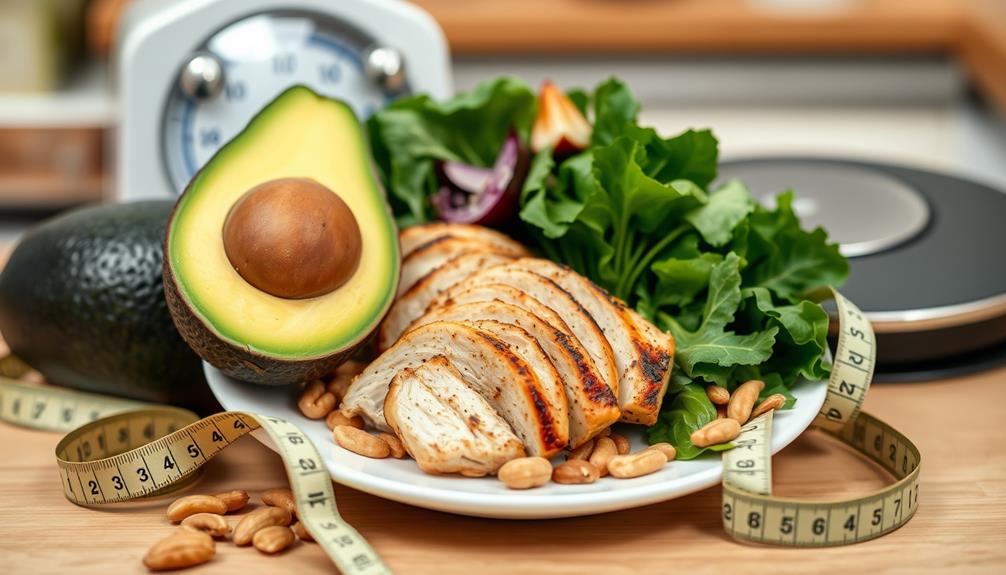
The ketogenic diet's effectiveness in promoting weight loss has garnered significant attention, and many people find it appealing for its unique approach to fat metabolism and appetite suppression.
Research shows that you can achieve an average weight loss of 2 pounds more than with low-fat diets, thanks to the diet's ability to enhance insulin sensitivity and reduce caloric intake. Additionally, the emotional and psychological growth associated with achieving weight loss goals can support overall wellbeing, highlighting the importance of a balanced approach to health, including factors like key domains of development in psychology.
Here are three key factors that make the ketogenic diet stand out:
- Rapid Initial Weight Loss: You might notice quick results due to glycogen depletion and water loss, giving you a motivational boost early on.
- Sustained Fat Loss: As you stick with the high-fat diet, significant fat loss can occur, especially in older adults after just eight weeks.
- Reduced Hunger: The ketogenic diet lowers hunger hormones, which can help you naturally eat less and achieve your weight loss goals.
While the short-term benefits are compelling, remember that long-term adherence can be challenging.
Many individuals experience weight regain when they return to higher carb intake. Therefore, it's crucial to reflect on your long-term strategy for maintaining weight loss.
Practical Tips for Success
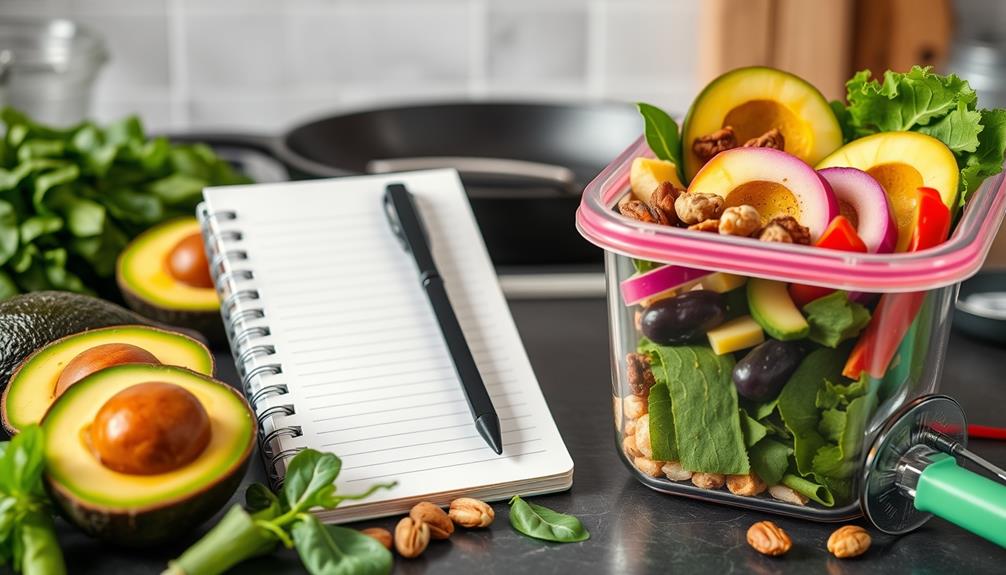
Success on the ketogenic diet hinges on preparation and knowledge. To maintain ketosis, familiarize yourself with food labels. You need to guarantee your meals contain 70-75% healthy fats, 20-25% protein, and only 5-10% carbohydrates. Stick to a strict carbohydrate limit of 20-50 grams of carbs per day to stay on track.
Meal planning is essential; it helps you avoid high-carb temptations. Use websites and cookbooks dedicated to keto recipes to keep your meals varied and enjoyable. This approach not only enhances your meals but also assists in adhering to your low-carb diet.
If you're short on time, consider meal delivery services that cater to ketogenic diets. These services provide ready-to-eat, compliant meals that can save you time and effort.
Lastly, always bring your own keto-friendly snacks to social gatherings. This strategy helps you resist the urge to indulge in high-carb foods that others may offer, keeping you aligned with your dietary goals.
Frequently Asked Questions
What Are the Best Keto Diet Rules?
To succeed on the keto diet, limit carbs to 20-50 grams daily, focus on healthy fats, include low-carb veggies, avoid sugars and grains, and stay hydrated while considering electrolyte supplements for balance.
What Is the Best Explanation of the Keto Diet?
The keto diet's best explanation is it's a low-carb, high-fat approach that shifts your body into ketosis, where you burn fat for energy. It requires careful planning to maintain nutrient balance and overall health.
What Is the Most Important Thing in Keto Diet?
Did you know that over 60% of people on a ketogenic diet struggle to maintain ketosis? The most important thing is to reduce carbs considerably, ensuring your body shifts to burning fat for energy effectively.
What Is the Trick to Keto Diet?
The trick to the keto diet is planning. By prepping low-carb meals and snacks ahead of time, you'll avoid cravings and guarantee you stick to your goals. Stay hydrated and monitor your ketone levels too!
Conclusion
In the vibrant landscape of dieting, the keto diet stands out like a beacon, promising a transformative journey. As you navigate through its twists and turns, embrace the mouthwatering flavors of healthy fats while steering clear of sugary traps. Picture yourself shedding pounds and gaining energy, feeling lighter with each step. With practical tips and a clear roadmap, you're not just initiating a diet; you're crafting a lifestyle. So, gear up and plunge into this exciting adventure of health!
